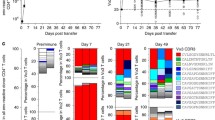Abstract
T lymphocytes possessing helper function produce soluble factors that greatly augment B-cell proliferation and differentiation into antibody-secreting cells1. In humans the subset of T lymphocytes bearing the T4 surface antigen comprises most of the cells that display helper activity and recognize class II antigens of the major histocompatibility complex (MHC), while the subset bearing the T8 antigen comprises T cells recognizing class I MHC antigens and exhibiting cytotoxic or suppressor function1–3. Monoclonal antibodies to T4 or T8 greatly inhibit the cognitive and effector function of cells with the corresponding phenotype1–4. This function/phenotype correlation is not absolute, however, for there are many examples of T8-positive clones that recognize MHC class II antigens and have helper activity, as well as of T4-positive clones with suppressor or cytotoxic function5–9. Recently a family of cell-surface neoantigens, which might be relevant to T-cell function and which are present on activated but not on resting T lymphocytes, has been identified in mouse and humans using monoclonal antibodies10. Some of these antibodies block the cytolytic activity of alloreactive T-cell clones, suggesting the possible involvement of such molecules in the activation of cytotoxic T-cell clones or in the lytic process itself10–13. We now describe a similar late-differentiation antigen (LDA1) that is expressed by human T lymphocytes only following activation and is recognized by a monoclonal antibody that inhibits the antibody-inducing helper function of T lymphocytes.
Similar content being viewed by others
References
Hood, L. E., Weissman, I. L., Wood, W. B. & Wilson, J. H. (eds) in Immunology 259–314 (Banjamin/Cummings, Menlo Park, 1984).
Reinherz, E. L. & Schlossman, S. F. Cell 19, 821–827 (1980).
Reinherz, E. L., Kung, P., Goldstein, G. & Schlossman, F. Proc. natn. Acad. Sci. U.S.A. 76, 4061–4065 (1979).
Littman, D. R., Thomas, Y., Maddon, P. J., Chess, L. & Axel, R. Cell 40, 237–246 (1985).
Jeannet, M. & Chardonnens, X. Transplantn Proc. 17, 714–715 (1985).
Flomenberg, N., Duffy, E. & DuPont, B. Scand. J. Immun. 19, 237–245 (1984).
Rohowsky, C., Kung, P., King, D. W. & Suciu-Foca, N. Hum. Immun. 9, 103–110 (1984).
Suciu-Foca, N. et al. Fedn Proc. 44, 107–109 (1985).
Davignon, D., Martz, E., Reynolds, T., Kurzinger, K. & Springer, T. J. Immun. 127, 590–595 (1981).
Dongworth, D. W. & McMichael, A. J. Br. med. Bull. 40, 254–261 (1984).
Sanchez-Madrid, F. et al. Proc. natn. Acad. Sci. U.S.A 79, 7489–7493 (1982).
Hildreth, J. E. K., Gotch, F. M., Hildreth, D. K. & McMichael, A. J. Eur. J. Immun. 13, 202–208 (1983).
Lefrancois, L. & Bevan, M. J. Nature 314, 449–452 (1985).
Haars, R., Rohowsky, C., Reed, E., King, D. W. & Suciu-Foca, N. Immunogenetics 20, 397–405 (1984).
Rohowsky, C., Bonagura, V., Lewison, A., King, D. W. & Suciu-Foca, N. Hum Immun. 11, 173–182 (1984).
Welte, K. et al. J. exp. Med. 160, 1390–1402 (1984).
Toyonaga, B., Yanagi, Y., Suciu-Foca, N., Miden, M. & Mak, T. W. Nature 311, 385–387 (1984).
Suciu-Foca, N., Rubinstein, P., Popovic, M., Gallo, R. & King, D. W. Nature 312, 275–277 (1984).
Parham, P. Immunogenetics 13, 509–528 (1981).
Lampson, L. A. & Levy, R. J. Immun. 125, 293–299 (1980).
Suciu-Foca, N., Rohowsky, C., Kung, P. & King, D. W. Hum. Immun. 9, 37–47 (1984).
Author information
Authors and Affiliations
Rights and permissions
About this article
Cite this article
Suciu-Foca, N., Reed, E., Rubinstein, P. et al. A late-differentiation antigen associated with the helper inducer function of human T cells. Nature 318, 465–467 (1985). https://doi.org/10.1038/318465a0
Received:
Accepted:
Issue Date:
DOI: https://doi.org/10.1038/318465a0
- Springer Nature Limited
This article is cited by
-
Complexes of soluble HLA antigens and anti-HLA autoantibodies in human sera: Possible role in maintenance of self-tolerance
Immunologic Research (1989)
-
NDA3: A differentiation antigen associated with the receptor for B cell growth factor
Immunologic Research (1986)





